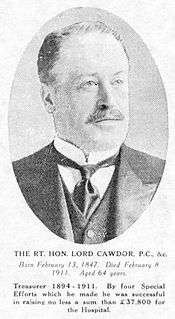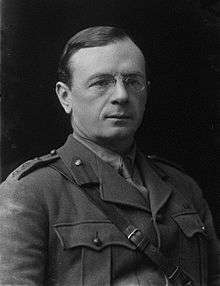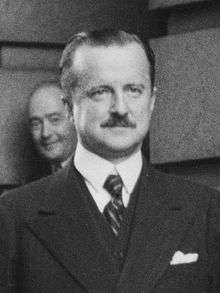First Lord of the Admiralty
| Office of the First Lord of the Admiralty | |
|---|---|
|
Seal of H.M. Government | |
| Department of the Admiralty | |
| Member of | Board of Admiralty |
| Reports to | Prime Minister |
| Nominator | Prime Minister |
| Appointer |
Prime Minister Subject to formal approval by the Queen-in-Council |
| Term length | Not fixed (typically 3–7 years) |
| Inaugural holder | Richard Weston, 1st Earl of Portland |
| Formation | 1628-1964 |
The First Lord of the Admiralty[1] or formally the Office the First Lord of the Admiralty[2] was the political head of the Royal Navy who was the government's senior advisor on all naval affairs and responsible for the direction and control of Admiralty Department as well as general administration of the Naval Service of the United Kingdom, that encompassed the Royal Navy, the Royal Marines and other services. It was one of the earliest known permanent government posts, apart from being the political head of the Royal Navy the post holder simultaneously held the title of the President of the Board of Commissioners for Exercising the Office of Lord High Admiral (known as the Board of Admiralty). The office of First Lord of the Admiralty existed from 1628 until it was abolished when the Admiralty, Air Ministry, Ministry of Defence and War Office were all merged to form the new Ministry of Defence in 1964.
History
In 1628, during the reign of Charles I, the Duke of Buckingham, Lord High Admiral of England, was assassinated and the office was placed in commission, under the control of a Board of Commissioners.
The first such First Lord of the Admiralty was Richard Weston, 1st Earl of Portland, who was appointed in 1628 the First Lord was not always a permanent member of the board until the Admiralty Department was established as an official government department in 1709[3] with the First Lord as its head, it replaced the earlier Office of the Admiralty and Marine Affairs,.[4] During most of the 17th century and the early 18th century, it was not invariable for the Admiralty to be in commission, so there are gaps in the list of First Lords, and a small number of First Lords were for a time Lord High Admiral.
After the Revolution, in 1690, a declaratory Act was passed, during the reign of William and Mary, Parliament passed the Admiralty Act, vesting in the Commissioners the powers formerly held by the Lord High Admiral of England.[5] and at this point became a permanent Cabinet position.
The Admiralty Commission was dissolved in 1701, but was reconstituted in 1709 on the death of Prince George of Denmark,[6] who had been appointed Lord High Admiral. The office has been held in commission from that time onwards, however, except for a short period (1827–28) when the Duke of Clarence was Lord High Admiral. The Board of the Admiralty comprised a number of “Lords Commissioners” headed by a First Lord.[7]
From the early 1800s the post was always held by a civilian[8] (previously flag officers of the Royal Navy also held the post). In 1832 First Lord Sir James Graham instituted reforms and amalgamated the Board of Admiralty and the Navy Board. By the provisions of the Admiralty Act of 1832, two Lords in committee could legalize any action of the Board.[9]
In 1868 Prime Minister, William Gladstone appointed Hugh Childers First Lord, who would introduce a new system at the Admiralty. However these changes restricted communication between the board members who were affected by these new regulations and the sittings of the Board were discontinued altogether. This situation described was further exacerbated by the disaster of HMS Captain in 1870, a poorly-designed new vessel for the navy.
The responsibility and powers of the First Lord of the Admiralty were laid down by an Order in Council dated January 14, 1869,[10] and a later Order (March 19, 1872) made the First Lord responsible to the Sovereign and to Parliament for all the business of the Admiralty. However by describing the Lords of the Admiralty as the "assistants" of the First Lord,[11] and by specifically defining their duties, had, in fact, partially disabled the collective power of the Board .
In 1931, for the first time since 1709, the First Lord was not a member of the cabinet.[12] In 1964, the office of First Lord of the Admiralty was abolished, the last holder being the second Earl Jellicoe, the son of Admiral of the Fleet Earl Jellicoe, and the functions of the Sea Lords were then transferred to the Admiralty Board, which forms part of the tri-service Defence Council of the United Kingdom.
Responsibilities and duties
Between 1800 and 1912 included:[13]
| No | Responsibility |
|---|---|
| 1 | Appointments to Commands. . |
| 2 | Appointment of Chaplains and Naval Instructors. |
| 3 | Appointments of Flag Officers, Captains, Officers Commanding Ships, Commanders to Coast Guard, Inspectors and Deputy Inspectors of Hospitals and holding Civil Appointments. |
| 4 | Appointment of Flag Officers and Officers in Command, including Engineer Rear-Admirals, Surgeons-General, and Staff Appointments of Royal Marines. |
| 5 | Appointments and Promotions—Private Office. |
| 6 | Board Questions.. |
| 7 | Civil Appointments. |
| 8 | Civil Appointments and Promotions, except as provided under Controller and Civil Lord. |
| 9 | Civil Appointments and Promotions (higher posts). |
| 10 | Foreign Navies and Intelligence.. |
| 11 | General Direction and Supervision. |
| 12 | General Direction and Supervision of all business relating to the Navy. Political and Board Questions.. |
| 13 | Harbours of Refuge. |
| 14 | Honours and Distinctions. |
| 15 | Mersey Conservancy.. |
| 16 | Naval Cadetships and Nominations to Assistant Clerkships, R.N.. |
| 17 | Navy Estimates and Financial Questions. |
| 18 | New Works. |
| 19 | Political Questions. |
| 20 | Promotions. |
| 21 | Promotions and Removals from the Service of Naval and Marine Officers. Honours and Rewards. |
| 23 | Railways. |
| 24 | Royal Yachts, including Appointment of all Officers. |
| 25 | Royal yachts, and Admiralty Yacht, including Appointment of all Officers. |
| 26 | Slave Trade. |
First Lords of the Admiralty of England, 1628–1701
| Portrait | Name | Term of office | Ref | |
|---|---|---|---|---|
 |
The Earl of Portland | 1628 | 1635 | [14] |
 |
The Earl of Lindsey | 1635 | 1636 | [15] |
 |
William Juxon, Bishop of Lincoln | 1636 | 1638 | [16] |
 |
The Earl of Northumberland (Lord High Admiral 1638–1642) |
1642 | 1643 | [17] |
 |
The Lord Cottington | 1643 | 1646 | [18] |
 |
Sir Henry Capell (Lord High Admiral 1638–1642) |
1679 | 1681 | [19] |
 |
The Earl of Nottingham | 1681 | 1684 | [20] |
 |
The Earl of Torrington (Lord High Admiral 1689) |
1689 | 1690 | [21] |
 |
The Earl of Pembroke | 1690 | 1692 | [22] |
 |
The Lord Cornwallis | 1692 | 1693 | [23] |
 |
The Viscount Falkland | 1693 | 1695 | [24] |
 |
The Earl of Orford | 1694 | 1699 | [25] |
 |
The Earl of Bridgewater | 1699 | 1701 | [26] |
 |
The Earl of Pembroke | 1701 | 1702 | [27] |
First Lords of the Admiralty of Great Britain, 1709–1801
| Name | Image | In office | Left office | Ref |
|---|---|---|---|---|
 |
The Earl of Orford | 1709 | 1710 | [28] |
 |
Sir John Leake | 1710 | 1712 | [29] |
_Diplomat.jpg) |
The Earl of Strafford | 1712 | 1714 | [30] |
 |
The Earl of Orford | 1714 | 1716 | [31] |
 |
The Earl of Berkeley | 1717 | 1727 | [32] |
 |
The Viscount Torrington | 1727 | 1733 | [33] |
 |
Sir Charles Wager | 1733 | 1741 | [34] |
%2C_8th_Earl_of_Winchilsea%2C_3rd_Earl_of_Nottingham%2C_by_Thomas_Worlidge.jpg) |
The Earl of Winchilsea | 1741 | 1744 | [35] |
 |
The Duke of Bedford | 1744 | 1748 | [36] |
 |
The Earl of Sandwich | 1748 | 1751 | [37] |
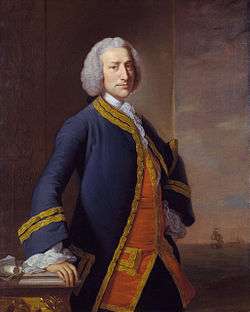 |
The Lord Anson | 1751 | 1756 | [38] |
 |
The Earl Temple | 1756 | 1757 | [39] |
%2C_8th_Earl_of_Winchilsea%2C_3rd_Earl_of_Nottingham%2C_by_Thomas_Worlidge.jpg) |
The Earl of Winchilsea | 1757 | 1757 | [40] |
 |
The Lord Anson | 1757 | 1762 | [41] |
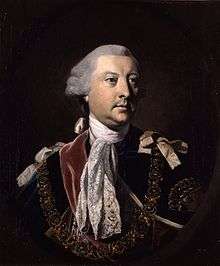 |
The Earl of Halifax | 1762 | 1762 | [42] |
_by_William_Hoare_(1707-1792).jpg) |
Hon. George Grenville | 1762 | 1763 | [43] |
 |
The Earl of Sandwich | 1763 | 1763 | [44] |
 |
The Earl of Egmont | 1763 | 1766 | [45] |
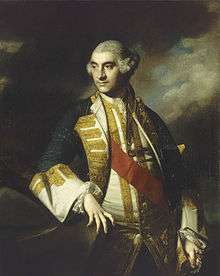 |
Sir Charles Saunders | 1766 | 1766 | [46] |
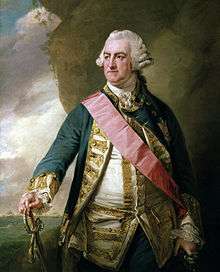 |
Sir Edward Hawke | 1766 | 1771 | [47] |
 |
The Earl of Sandwich | 1771 | 1782 | [48] |
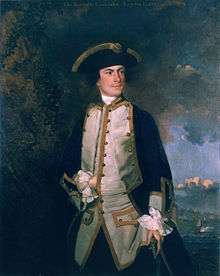 |
The Viscount Keppel | 1782 | 1783 | [49] |
 |
The Viscount Howe | 1783 | 1783 | [50] |
 |
The Viscount Keppel | 1783 | 1783 | [51] |
 |
The Viscount Howe | 1783 | 1788 | [52] |
| |
The Earl of Chatham | 1788 | 1794 | [53] |
 |
The Earl Spencer | 1794 | 1801 | [54] |
First Lords of the Admiralty of the United Kingdom, 1801–1964
Boards, departments and offices under the First Lord
- Office of Admiralty and Marine Affairs, (1628-1709)
- Admiralty Department, (1709-1964)
- Board of Admiralty, (1628-1964)
- Navy Board, (1628-1832)
- Sick and Hurt Board, (1653-1806)
- Transport Board, (1690-1724, 1794-1817)
- Victualling Board, (1683-1832)
- Office of the Civil Lord of the Admiralty
- Office of the Senior Naval Lord, (1689-1771)
- Office of the First Naval Lord, (1771-1904)
- Office of the First Sea Lord, (1904-1917)
- Office of the First Sea Lord and Chief of Naval Staff, (1917-1964)
- Office of the Private Secretary to the First Lord of the Admiralty, (1800-1910)
- Office of the Naval Secretary, (1910-1964)
- Office of the Secretary to the Admiralty, (1660-1763)
- Office of the First Secretary to the Admiralty, (1763-1871)
- Office of the Parliamentary Secretary to the Admiralty, (1871-1886)
- Office of the Parliamentary and Financial Secretary to the Admiralty, (1886-1959)
- Office of the Permanent Secretary to the Admiralty
Fictional First Lords
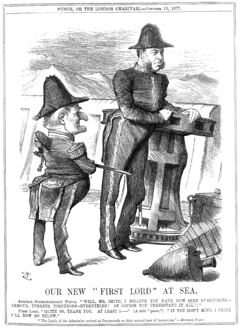
The "Radical" First Lord, and a major character, in Gilbert and Sullivan's comic opera H.M.S. Pinafore (1878), is Sir Joseph Henry Porter, KCB. W. S. Gilbert wrote to Arthur Sullivan he did not intend to portray the real-life then First Lord, the bookseller and newsagent W. H. Smith, a Conservative,[55] although some of the public, including Prime Minister Disraeli (who later referred to Smith as "Pinafore Smith"), identified Porter with him.[56] The counterparts shared a known lack of naval background. It has been suggested the character was drawn on Smith's actual "Radical" predecessor of 1868–71, Hugh Childers.[57]
References
- ↑ Eberle, Sir James (2007). Wider horizons: naval policy & international affairs. Roundtuit Publishing. p. 1. ISBN 9781904499176.
- ↑ Pryde, E. B. (Feb 23, 1996). Handbook of British Chronology. Cambridge University Press. p. 135. ISBN 9780521563505.
- ↑ Blake, Nicholas; Lawrence, Richard (2005). The Illustrated Companion to Nelson's Navy. Stackpole Books. p. 8. ISBN 9780811732758.
- ↑ Knighton, C. S.; Loades, David; Loades, Professor of History David (Apr 29, 2016). Elizabethan Naval Administration. Routledge. p. 8. ISBN 9781317145035.
- ↑ Hamilton, Admiral Sir. Richard. Vesey, G.C.B. (1896). Naval Administration: The Constitution, Character, and Functions of the Board of Admiralty, and of the Civil Departments it Directs. George Bell and Sons, London.
 This article incorporates text from this source, which is in the public domain.
This article incorporates text from this source, which is in the public domain. - ↑ Blake, Nicholas; Lawrence, Richard (2005). The Illustrated Companion to Nelson's Navy. Stackpole Books. p. 8. ISBN 9780811732758.
- ↑ Hamilton, Admiral Sir. Richard. Vesey, G.C.B. (1896). Naval Administration: The Constitution, Character, and Functions of the Board of Admiralty, and of the Civil Departments it Directs. George Bell and Sons, London.
 This article incorporates text from this source, which is in the public domain.
This article incorporates text from this source, which is in the public domain. - ↑ Constable, Archibald (1861). The Edinburgh Review, Or Critical Journal: ... To Be Continued Quarterly. Austrian National Library, 4 Nov 2013. p. 291.
- ↑ (eISB), electronic Irish Statute Book. "electronic Irish Statute Book (eISB), Admiralty Act, 1832". irishstatutebook.ie. Government of Ireland, 2017. Retrieved 9 March 2017.
- ↑ Hamilton, C.I. (2011). The making of the modern admiralty : British naval policy-making 1805-1927. Cambridge, UK: Cambridge University Press. p. 153. ISBN 9780521765183.
- ↑ Marder, Arthur (Jun 19, 2014). From the Dreadnought to Scapa Flow: Volume II: To The Eve of Jutland 1914-1916. Seaforth Publishing. p. 268. ISBN 9781848321632.
- ↑ Cannon, John; Crowcroft, Robert (2015). The Oxford Companion to British History. Oxford University Press. p. 5. ISBN 9780199677832.
- ↑ Archives, The National. "Organisation of Admiralty Business". discovery.nationalarchives.gov.uk. National Archives, 1885-1923, ADM 116/3392. Retrieved 8 March 2017.
 This article contains text from this source, which is available under the Open Government Licence v3.0. © Crown copyright.
This article contains text from this source, which is available under the Open Government Licence v3.0. © Crown copyright. - ↑
 Lee, Sidney, ed. (1899). "Weston, Richard (1577-1635)". Dictionary of National Biography. 60. London: Smith, Elder & Co. p. 364.
Lee, Sidney, ed. (1899). "Weston, Richard (1577-1635)". Dictionary of National Biography. 60. London: Smith, Elder & Co. p. 364. - ↑
 "Bertie, Robert". Dictionary of National Biography. London: Smith, Elder & Co. 1885–1900.
"Bertie, Robert". Dictionary of National Biography. London: Smith, Elder & Co. 1885–1900. - ↑ Thomas Mason, Serving God and Mammon: William Juxon, 1582–1663 (ISBN 0-87413-251-7)
- ↑ Thomas Mason, Serving God and Mammon: William Juxon, 1582–1663 (ISBN 0-87413-251-7)
- ↑ Thomas Mason, Serving God and Mammon: William Juxon, 1582–1663 (ISBN 0-87413-251-7)
- ↑ N.Y.), Metropolitan Museum of Art (New York; Baetjer, Katharine (2009). British Paintings in the Metropolitan Museum of Art, 1575-1875. Metropolitan Museum of Art. p. 19. ISBN 9781588393487.
- ↑ Phillips, G. (Nov 29, 2012). Rutland. Cambridge University Press. p. 132. ISBN 9781107696419.
- ↑ Stewart, William (Sep 28, 2009). Admirals of the World: A Biographical Dictionary, 1500 to the Present. McFarland. p. 163. ISBN 9780786482887.
- ↑ Cannon, John; Crowcroft, Robert (2015). The Oxford Companion to British History. Oxford University Press. p. 714. ISBN 9780199677832.
- ↑ Murray, J. (1859). Correspondence of Charles, First Marquis Cornwallis. J. Murray. p. 2.
- ↑ Fieldgate, Barrie (2007). The Captain's Steward: Falklands, 1982. Melrose Press. p. 305. ISBN 9781905226467.
- ↑ Aldridge, David Denis (2009). Admiral Sir John Norris and the British Naval Expeditions to the Baltic Sea 1715-1727. Nordic Academic Press. p. 286. ISBN 9789185509317.
- ↑ Macaulay, Thomas Babington, Baron Macaulay (1915). The History of England: From the Accession of James the Second, Volume 6. Macmillian. p. 3018.
- ↑ Office-Holders in Modern Britain: Volume 4, Admiralty Officials 1660-1870
- ↑ Childs, John (1991). The Nine Years' War and the British Army, 1688-1697: The Operations in the Low Countries. Manchester University Press. p. 353. ISBN 9780719034619.
- ↑ Winfield, Rif (Mar 10, 2010). British Warships in the Age of Sail 1603-1714: Design, Construction, Careers and Fates. Seaforth Publishing. p. 23. ISBN 9781783469246.
- ↑ Holmes, Geoffrey (1987). British Politics in the Age of Anne. A&C Black. p. 541. ISBN 9780907628736.
- ↑ Aldridge, David Denis (2009). Admiral Sir John Norris and the British Naval Expeditions to the Baltic Sea 1715-1727. Nordic Academic Press. p. 286. ISBN 9789185509317.
- ↑ Stewart, William (Sep 28, 2009). Admirals of the World: A Biographical Dictionary, 1500 to the Present. McFarland. p. 28. ISBN 9780786438099.
- ↑ Howard, Joseph J.; Crisp, Joseph J. Howard Frederick A. (Sep 1, 1997). Visitation of England and Wales Notes: Volume 6 1906. Heritage Books. p. 172. ISBN 9780788407031.
- ↑ Cunningham, George Godfrey (1853). A History of England in the Lives of Englishmen. A. Fullarton. p. 169.
- ↑ Sainty, J. C. "'Alphabetical list of officials: K-Z', in Office-Holders in Modern Britain: Volume 4, Admiralty Officials 1660-1870". british-history.ac.uk. Originally published by University of London, London, 1975, pp.135-159. Retrieved 9 March 2017.
- ↑ Newman, Gerald; Brown, Leslie Ellen (1997). Britain in the Hanoverian Age, 1714-1837: An Encyclopedia. Taylor & Francis. p. 619. ISBN 9780815303961.
- ↑ Woodward, Bernard Bolingbroke; Cates, William Leist Readwin (1872). Encyclopedia of Chronology: Historical and Biographical. Longmans, Green and Company. p. 1246.
- ↑ Stewart, William (Sep 28, 2009). Admirals of the World: A Biographical Dictionary, 1500 to the Present. McFarland. p. 9. ISBN 9780786482887.
- ↑ Winfield, Rif (Dec 12, 2007). British Warships in the Age of Sail 1714-1792: Design, Construction, Careers and Fates. Seaforth Publishing. p. viii Introduction. ISBN 9781783469253.
- ↑ Sainty, J. C. "'Alphabetical list of officials: K-Z', in Office-Holders in Modern Britain: Volume 4, Admiralty Officials 1660-1870". british-history.ac.uk. Originally published by University of London, London, 1975, pp.135-159. Retrieved 9 March 2017.
- ↑ Watson, John Steven (1960). The Reign of George III, 1760-1815. Clarendon Press. p. 613. ISBN 9780198217138.
- ↑ Kane, Joseph Nathan; Aiken, Charles Curry (2005). The American Counties: Origins of County Names, Dates of Creation, and Population Data, 1950-2000. Scarecrow Press. p. 123. ISBN 9780810850361.
- ↑ Chatham.), William Pitt (1st earl of (1838). Correspondence, ed. by [W.S. Taylor and J.H. Pringle] the executors of his son John, earl of Chatham. Oxford University. p. xxi Introduction.
- ↑ Chatham.), William Pitt (1st earl of (1838). Correspondence, ed. by [W.S. Taylor and J.H. Pringle] the executors of his son John, earl of Chatham. Oxford University. p. xxi Introduction.
- ↑ Chatham.), William Pitt (1st earl of (1838). Correspondence, ed. by [W.S. Taylor and J.H. Pringle] the executors of his son John, earl of Chatham. Oxford University. p. xxi Introduction.
- ↑ Beatson, Robert (1788). A Political Index to the Histories of Great Britain and Ireland: Or, A Complete Register of the Hereditary Honours, Public Offices, and Persons in Office, from the Earliest Periods to the Present Time. G. G. J. & J. Robinson. p. 320.
- ↑ Watson, John Steven (1960). The Reign of George III, 1760-1815. Clarendon Press. p. 623. ISBN 9780198217138.
- ↑ Laurens, Henry (1980). The papers of Henry Laurens. Univ of South Carolina Press. p. 56. ISBN 9780872493858.
- ↑ Bandhauer, Andrea; Veber, Maria (2009). Migration and Cultural Contact: Germany and Australia. Sydney University Press. p. 214. ISBN 9781920898632.
- ↑ Haydn, Joseph (1851). The Book of Dignities: Containing Lists of the Official Personages of the British Empire ... from the Earliest Periods to the Present Time ... Together with the Sovereigns and Rulers of Europe, from the Foundation of Their Respective States; the Peerage of England and Great Britain ... Longmans, Brown, Green and Longmans. p. 286.
- ↑ Bolton, Carol (Jun 3, 2016). Letters from England: By Don Manuel Alvarez Espriella. Routledge. p. 508. ISBN 9781317242918.
- ↑ Haydn, Joseph Timothy; Beatson, Robert (1851). Beatson's Political index modernised. The book of dignities; containing rolls of the official personages of the British empire, together with the sovereigns of Europe, the peerage of England and of Great Britain; and numerous other lists. Oxford University. p. 286.
- ↑ Nichols, John (1835). The Gentleman's Magazine. E. Cave. p. 546.
- ↑ Hawkins, Anne (Jun 17, 2016). Letters of Seamen in the Wars with France, 1793-1815. Boydell & Brewer. p. 482. ISBN 9781843838968.
- ↑ Jacobs, Arthur (1986). Arthur Sullivan - A Victorian Musician. Oxford University Press. p. 114. ISBN 0-19-282033-8.
- ↑ Arthur Sullivan, A Victorian Musician. p. 115.
- ↑ Oxford Dictionary of National Biography, Volume 11. Oxford University Press. 2004. p. 445.Article on Childers by William Carr, rev H. C. G. Matthew.
Attribution
This article contains some text from: Vesey, Richard Sir, Admiral, (1896), Naval Administration: The Constitution, Character, and Functions of the Board of Admiralty, and of the Civil Departments it Directs, George Bell and Sons, London. Now in the public domain.
Sources
- Hamilton, C. I. (2011). The Making of the Modern Admiralty: British Naval Policy-Making, 1805-1927. Cambridge: Cambridge University Press. ISBN 9780521765183.
- Rodger, N.A.M. The Admiralty (Lavenham, 1979)
- Sainty, J. C. Admiralty Officials, 1660–1870 (London, 1975)
.svg.png)


%2C_by_Isaac_Pocock.jpg)

.jpg)











%2C_4th_Duke_of_Northumberland_by_Francis_Grant.jpg)





_.jpg)
.jpg)
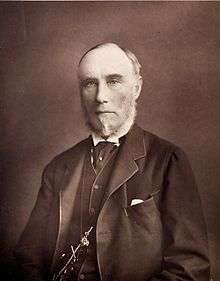


.jpg)
